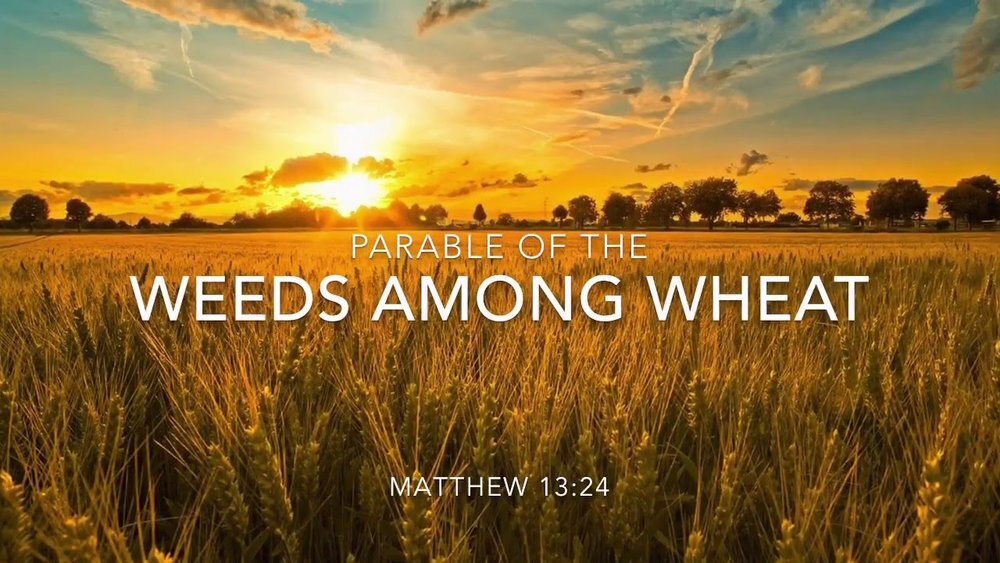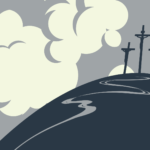Jesus used parables as the chief means of his story-telling. A parable is a story told in a specific way, often to make a single clear point. Parables are conundrums. They contain unresolved tensions. They invite multiple understandings. They press for exploration and investigation. We have another parable in the Gospel reading for this coming Sunday!
The accounts of Jesus that we have in scripture—Mark’s beginning of the good news of Jesus, Matthew’s book of origins of Jesus, Chosen One, and Luke’s orderly account of the things fulfilled—each contain a number of parables. Even in John’s book of signs, there are some parable-like sections, buried in the midst of the long discourses that this book contains.
Last week (Pentecost 7A), we had the parable of the seeds and the sower (13:3-9) and its interpretation (13:18-23). This week (Pentecost 8A), we will hear the parable of the weeds among the wheat (13:24-30) and its interpretation (13:36-43). Then in the following week (Pentecost 9A), we will hear the other five parables in this chapter: the mustard seed (13:31-32), the yeast in the flour (13:33), hidden treasure (13:44), a pearl of great value (13:45-46), and the net that caught fish (13:47-48)—each one offered without interpretation.
As with last week, so also this week we are given a parable, followed immediately by an interpretation of the parable. I had a spout last week about the way that a later allegorising understanding of the parable has been placed on the lips of Jesus, in this Gospel account. You can read that here.
However, Elizabeth and I have had a rolling conversation about parables, and how they were seen and used in Judaism. The idea that the allegorising interpretation was a later addition, beyond the time of Jesus, has held sway for a number of decades in critical biblical scholarship. Christian scholars are dubious about whether Jesus would have utilise this somewhat hellenised approach to stories. (We know that allegories were in evidence centuries before Jesus in Greek literature. Whether Jesus knew this long tradition is debatable.)

Yet this critical Christian perspective overlooks the claim that Judaism, and the long stream of Jewish tellers of parables, have on such stories. Parables are found, in Jewish literature, in various forms. There are, for a start in Hebrew Scripture, a number of short, succinct, one-liners, often introduced as a simple comparison (“this is like that”), making just one focussed point. (Indeed, that is what the Greek word parabolē means—it signals two things that are “thrown beside” each other.)
The widow in Tekoa explains her plight to King David, explaining that “your servant had two sons, and they fought with one another in the field; there was no one to part them, and one struck the other and killed him; now the whole family has risen against your servant” (2 Sam 14:6–7).
When Ahab was king, a prophet waited beside the road, disguised with a bandage over his eyes, and taunts the king: “your servant went out into the thick of the battle; then a soldier turned and brought a man to me, and said, ‘Guard this man; if he is missing, your life shall be given for his life, or else you shall pay a talent of silver.’ While your servant was busy here and there, he was gone.” (1 Ki 20:38–40).
The “song of my lover about his vineyard” that Isaiah tells (Isa 5:1–7) is longer, but drives relentlessly to the single point: the Lord of hosts “expected justice, but saw bloodshed; righteousness, but heard a cry!”. Another agricultural parable relates the skill of the farmer who utilises good practices to produce abundant harvests; “they are well instructed; their God teaches them”, and so “this also comes from the Lord of hosts; he is wonderful in counsel, and excellent in wisdom” (Isa 28:24–29).
The classic example from Hebrew Scripture comes after David pursues Bathsheba, the wife of Uriah, after he has sent Uriah off into battle. The adultery of King David leads the prophet Nathan to confront him with a story about “a rich man who had many flocks” and “a poor man who had nothing but one little ewe lamb” (2 Sam 12:1–4).
As the story develops, and the rich man took the poor man’s lamb to feed a visitor, the king explodes into anger (2 Sam 12:5–6)—only to be met by the damning words of the prophet: “you are the man!” (2 Sam 12:7). The parable had drawn David into the web of the story, and there was now no escape!

In the parable of the weeds and the wheat which Jesus tells (Matt 13:24–30), there is a simple contrast drawn between the weeds and the wheat, and a story which develops so that the conclusion that is drawn can only be seen as inevitable. That simplicity, and also that technique of drawing the listener into the story, is typical of parables that Jesus told.
A number of the parables told be Jesus were indeed short and direct, making a single point and needing little explanation: see the parables of the treasure (13:44) and the pearl (13:45), for instance. This made the parable easy to remember and repeat orally.
These parables are little more than an introduction (“the kingdom of heaven is like…”) and a single image which is used to describe a characteristic of the kingdom (hidden treasure, or fine pearls). The first part of this week’s parable (13:24–26) has this form. It is short and direct.
It starts with the classic introduction, “the kingdom of heaven may be compared to …”. It goes on to tell of the good seeds, which grow into wheat, and the bad seeds, which grow into weeds. This part of the parable has a simple contrasting form, like the parable of the good fish and the bad fish caught in the net, as told in the last of the seven parables (13:47–48).
But the parable has a story attached to these weeds among the wheat (13:27–30). So Jesus continues with a little plot development, which brings in a reflection on the human characters who sowed the seeds. In this regard, this is like other parables of Jesus, which are a little more developed; they still make a single point, but it is developed or explained a little more. And the questions are raised … and the listeners ponder, and consider their responses …
This parable plays,quite cleverly, on the fact that there is, indeed, a type of “weed” which, for much of its life, looks quite like wheat (the bearded darnel, lolium temulentum, or Darnel Ryegrass). So it is a story which is quite credible in the scenario it proposes. And then, added to the actual parable, there comes a separate section that provides a strongly allegorised interpretation of what happened in the field where the wheat and the weeds grew (13:24–30).

That development in the plot of this parable, and the subsequent allegorical interpretation, might well relate to the fact that the Hebrew Scriptures also contain parables with developed plots and allegorical elements. In an allegory, particular individual features can play an independently figurative role, so that the story told becomes a kind of riddle which invites a response from the listener. “What do you think?” becomes the implied way that the allegory-riddle ends. Listening to the story is not enough—the listener needs to engage, enter the conundrum, make up their mind!
A classic short, simple riddle is that spoken by Samson, “out of the eater came something to eat; out of the strong came something sweet” (Judg 14:14). The narrative comment that follows is delightful: “for three days they could not explain the riddle”! Another example is the proverb quoted by two prophets, about the impact of the Exile: “the parents have eaten sour grapes, and the children’s teeth are set on edge” (Jer 31:29; Ezek 18:2). The point of this saying is clear, and telling.
In Hebrew Scripture, the allegory of the Eagles and the Vine (Ezek 17:3–10) is described as both ḥidah (“riddle”) and mashal in verse 2. The parable first describes “a great eagle, with great wings and long pinions”, who carried seed far away where it took root and became a vine (a classic symbol of Israel). It then offers a further description of “another great eagle, with great wings and much plumage”, which the teller of the parable fears may seek to uproot the vine.
“When it is transplanted, will it thrive”, the parable ends (v.10)—will Israel, transplanted into exile, manage to survive that experience? Then follows an explanation of the details of the parable (Ezek 17:11–21), relating the story to the immediate situation of Israel.
Further parable-riddles occur in subsequent chapters in Ezekiel. There is the Lamenting of the Lioness (Ezek 19:2–9) and the Transplanted Vine (Ezek 19:10–14), and the stories of the Harlot Sisters (ibid. 23:2–21). There is also one of my favourites, the very vivid—and gruesome—parable of the Cooking-Pot (Ezek 24:3b—5).
In this parable, the prophet warns the people of judgement: “set on the pot … pour in water … put in the pieces, the thigh and the shoulder … fill it with choice bones” (that is, the meat and bones of the Israelites being punished). The prophet concludes with a booming denunciation: “woe to the bloody city … the blood is shed inside it … to rouse my wrath, I have placed the blood she shed on on a bare rock” (Ezek 24:6–8, and then the metaphor extended still further in 24:9–14).

Each of these parables are clearly allegorical, in that the overall point is clear, and yet also the details in the story invite connection with specific people or events. Ezekiel is a powerful speaker, who utilises this dramatic story-form with great flair, and effect.
A third type of mashal is the fable, where animals or inanimate objects are made to speak and act like men. We know about fables in Greek literature from Aesop, of course, and in more recent literature through those tales collected by the Brothers Grimm; but the article on “Parables” in the Jewish Virtual Library notes a number of instances where Hebrew Scripture contains fables. One good example is Judges 9:8–15, where the trees confer as to who will become king. Another is 2 Kings 14:9–10, where a thornbush sends a message to a cedar, but a wild animal tramples down the thornbush. These fables can be seen to relate directly to the political situation of Israel at different times in their history.
The article on “Parable” in the Jewish Virtual Library also notes: “Mashal and ḥidah are used almost synonymously in Ezekiel 17:2; Habakkuk 2:6; Psalms 49:5 and 78:2; and Proverbs 1:6. Certain proverbs are in effect parable-riddles, e.g., Proverbs 30:15a, 15b–16, 18–19, and 21–31.
“Other biblical forms related to the parable type of mashal are: prophetic oracles where a metaphor is extended into a lively description, e.g., Isaiah 1:5–6; Hosea 2:2–15; 7:8–9, 11–12; Joel 4:13; and Jeremiah 25:15–29; prophetic oracles proclaimed through symbolic actions, e.g., I Kings 11:29; II Kings 13:15–19, and Isaiah 20:2–6; extended personifications as of Wisdom and Folly in Proverbs 1:20–33; 8:1–36; 9:1–6, 13–18; and revelatory dreams and visions having symbolism which the sequel interprets as allegorical, e.g., Genesis 37:6–11; 40:9–13, 16–19; Zechariah 1:8–11; 2:1–4; and Daniel 2:31–45.”
Beyond these many examples, there are the multitudes of parables in rabbinic literature (about which, see the further resources listed at the end of this blog).

Returning to the parable of the wheat and the weeds: if we take an agricultural approach to the story, it is a mystery why the weeds had to be burnt, and not just pulled out—as in the version of this parable found in the Gospel of Thomas—and composted—as would occur in my own gardening!
My own take would be that this links with the Jewish prophetic tendency to connect burning with God’s judgement (see Isa 27:2–4; Jer 4:4, 7:20, 15:14, 17:4; Nahum 1:13; Malachi 4:1; see also Ps 79:5, 89:46, and Exod 15:7). And we saw in my comments on the earlier parable that God’s judgement was a strong motif in the parables and teachings of Jesus, especially strengthened in Matthew’s account.
The parable of the mustard seed (13:31–32) is another example of a simple parable with a short plot development. This parable uses the same introductory phrase, “the kingdom of heaven is like …”, and conveys its main point in an image (mustard seed, 13:31) which is further developed to convey what happens to the mustard seed as it grows and forms “the greatest of shrubs” (13:32).
So the plot of the parable of the wheat and the weeds continues until the punchline is reached. It is not during the growing that any distinction is to be made; it is at the harvest that this distinction is enforced. Wheat that grew from good seeds is to be collected and stored; weeds that grew from bad seeds are to be bundled and burnt (13:28–30).
That much, as a parable, has a clear message: don’t intervene into the process of growing, don’t judge (recalling words of Jesus reported at Matt 7:1), but let the end result of the process of growing be the moment when the judgement occurs—and let that judgement be undertaken by God. And that taps into a strong interest, throughout the book of origins, for depicting Jesus as the eschatological preacher of judgement.
This probably explains one curious aspect of the parable, that we noted above: why the weeds had to be burnt, and not just pulled out. It connects with Jewish understandings of judgement. Consistently throughout the book of origins, Jesus is presented as a prophetic eschatological figure. And yet alongside that, he functions as a master story-teller, in the mode of prophets of old as well as the rabbis to come!
In his capacity as God’s Messiah, Jesus frequently promises (or threatens) judgement (5:21–26; 7:1–2; 10:15; 11:21–24; 12:36–37; 19:28– 30; 21:33–44; 22:1–14; 24:29–31, 36-44, 45–51; 25:1–13, 14–30, 31–46; 26:64). The language of burning in the eternal fire characterises both conclusions to parables of Jesus, and the warnings of earlier prophets. Many of these declarations occur in eschatological contexts, where Jesus is warning about the punishment that is to come at “the end of time”, unless the righteous-justice that he advocates is followed in the present.
In the previous chapter, a quotation from the prophet Isaiah (Isa 42:1–4, at Matt 12:15–21) includes an extended quotation from Isaiah 42, where the servant of the Lord proclaims judgement to the Gentiles and they are said to have hope in his name (presumably because they repent and believe him). This is the function that Jesus, as God’s servant, the Chosen One, carries out. It’s not for us human beings to take on the role of judge. That belongs to God, carried out through his chosen agent, Jesus.
The parable of the wheat and the weeds has an intensity because of its focus and orientation towards this fearsome judgement, executed by Jesus as “the Son of Man” (24:30–31), in obedience to the desire of God. The interpretation of the parable might be seen to defuse the intensity of the parable by fussing about what each element refers to: the Sower is the Son of Man, the good seeds are the children of the kingdom, the bad seeds are the children of the evil one, the enemy is the devil, and so on (13:39). But the end point remains clear: judgement is a hand!
The interpretation of the parable ends with a repetition and expansion of the scene of judgement that ended the parable—but the good seed is not simply stored, it morphs into the righteous in the kingdom, and the bad seed is not burnt as seed, but it becomes the ones who disobeyed the law, burning in the furnace (13:41–43). And there will be “weeping and gnashing of teeth” (13:42; see also 13:50; 22:14; 25:30). So the same punchline holds in this section, as in the parable itself.
Interestingly, the interpretation ends with the same punchline that concluded the parable of the seeds and the sower: let anyone with ears, listen! (13:43, cf. 13:9). Jesus continues to press the point. Judgement is inevitable. He will continue to articulate this ominous message throughout the remainder of the Gospel—right through to the sequence of the four parables of judgement that conclude the final teachings of Jesus (24:44—25:46). Let anyone with ears, listen, indeed!

This piece draws on material in Messiah, Mountains, and Mission: An Exploration of the Gospel for Year A, by Elizabeth Raine and John Squires (self-published 2012), and from ongoing conversations that Elizabeth and I have had about parables, Christian interpretation, Jewish storytelling techniques, and associated matters.
John Squires edits With Love To The World












1 thought on “Parables, riddles, and allegories: the craft of Jewish storytelling”
Thanks Elizabeth and John. I will continue to wrestle with the conundrums and to be further provoked by your revelations.